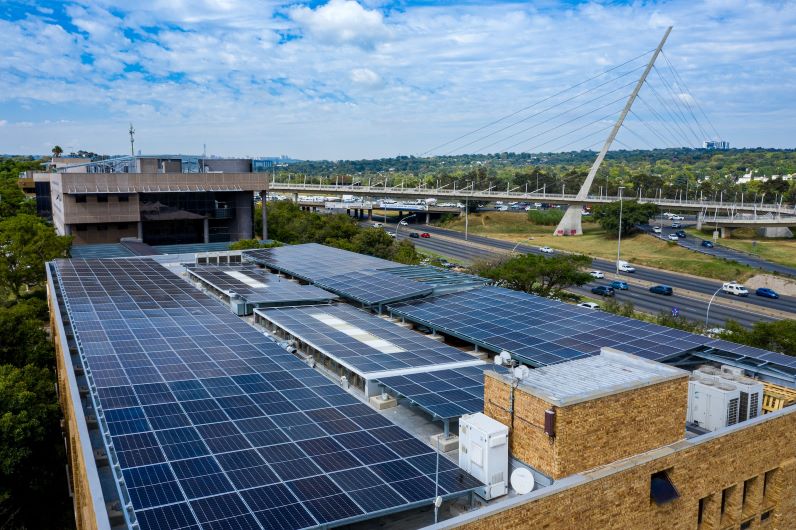
In a pioneering step towards energy independence and environmental sustainability, Wilson Bayly Holmes-Ovcon (WBHO), a leading South African construction company, has installed large-scale solar panel arrays on the three buildings of its headquarters in Wynberg, Johannesburg. The ‘Going Green’ project is a significant investment and part of the company’s commitment to renewable energy solutions as an integral part of modern construction. By reducing demand on Eskom electricity supply, WBHO will also help contribute to ensuring that that there is less pressure on the national grid.
What is ground-breaking about the project is the unique model WBHO has developed of the daily, weekly and seasonal load cycles of the premises to address the challenge of balancing the buildings’ unique fluctuations in energy demand and fluctuating solar supply supported by battery storage. This model enables the company to ensure safe, stable access to energy throughout the day, and can be refined and customised for wider application as a part of a future-orientated construction offering.
“Being able to define an optimal combination of technologies to meet inconsistent demand is a delicate dance to get it right. We took it hour by hour, day by day, across the seasons on a statistically determined basis, so that it makes technical and financial sense as well. Averages don’t work well in the world of electricity supply and demand matching. You have to hit the precise point where energy meets economy,” explained Russell Adams, Director at the Projects Division of WBHO.
As a consequence of the solar installation, the buildings can now mitigate up to prolonged Stage 5 loadshedding. As the offices remain connected to Eskom, WBHO hopes to eventually supply energy back into the grid in the future.
The project involved structural changes to the buildings with concrete blocks placed on the roofs to secure maximum solar panel metreage. 140 tons of ballast were placed on the roofs and 50 tons of steel mountings were installed.
The solar system will have a total capacity of 560 kWp, along with battery storage of 1576 kWh. The energy supply mix also includes 750 kW of inverter capacity.
“The investment in the project not only makes environmental sense, but it makes economic sense as well,” said Adams.” Prior to this project, the company spent in excess of R100,000 per month on diesel to mitigate stage 6 loadshedding at its head office. The ‘Going Green’ project is an investment of R20 million that will, in the long-term, pay for itself. But looking beyond immediate electricity concerns, this is a huge step in reducing our carbon footprint and contributing to a construction sector that is becoming more environmentally aware every day.”
The project, which is the culmination of years of planning, continues WBHO’s longstanding commitment to energy efficiency. It was preceded in 2016, by an energy audit, replacing all electrical equipment in the buildings with energy-efficient alternatives. In 2022, the company’s large plant and services yard in Chloorkop, Midrand, began to shift its energy mix towards greater reliance on large-scale photovoltaic arrays by installing a 336kW system there as well.
Solar power has also been a priority in some of WBHO’s Corporate Social Investment (CSI) projects. In 2021, the company supplied Maserunyane High School in Mapela, Limpopo with the energy delivered by a solar system of 19.2 kWp, 15kW inverter and 19.4kWh battery storage capacity installed on their premises.
The ‘Going Green’ project has also been an opportunity to upskill younger employees at the company. The experience and expertise gained in the modelling and construction of energy infrastructure are now being used on other much larger projects. “Our teams now use these cutting-edge learnings in bids for other clients. We can translate this relatively small-scale endeavour into big projects,” said Adams. WBHO is currently constructing solar projects totalling 325 MW.
The solar setup has a 20-year design life. The first of the three buildings of the head office will be fully operational this month, with the other two buildings to follow between the end of April and the beginning of May.

